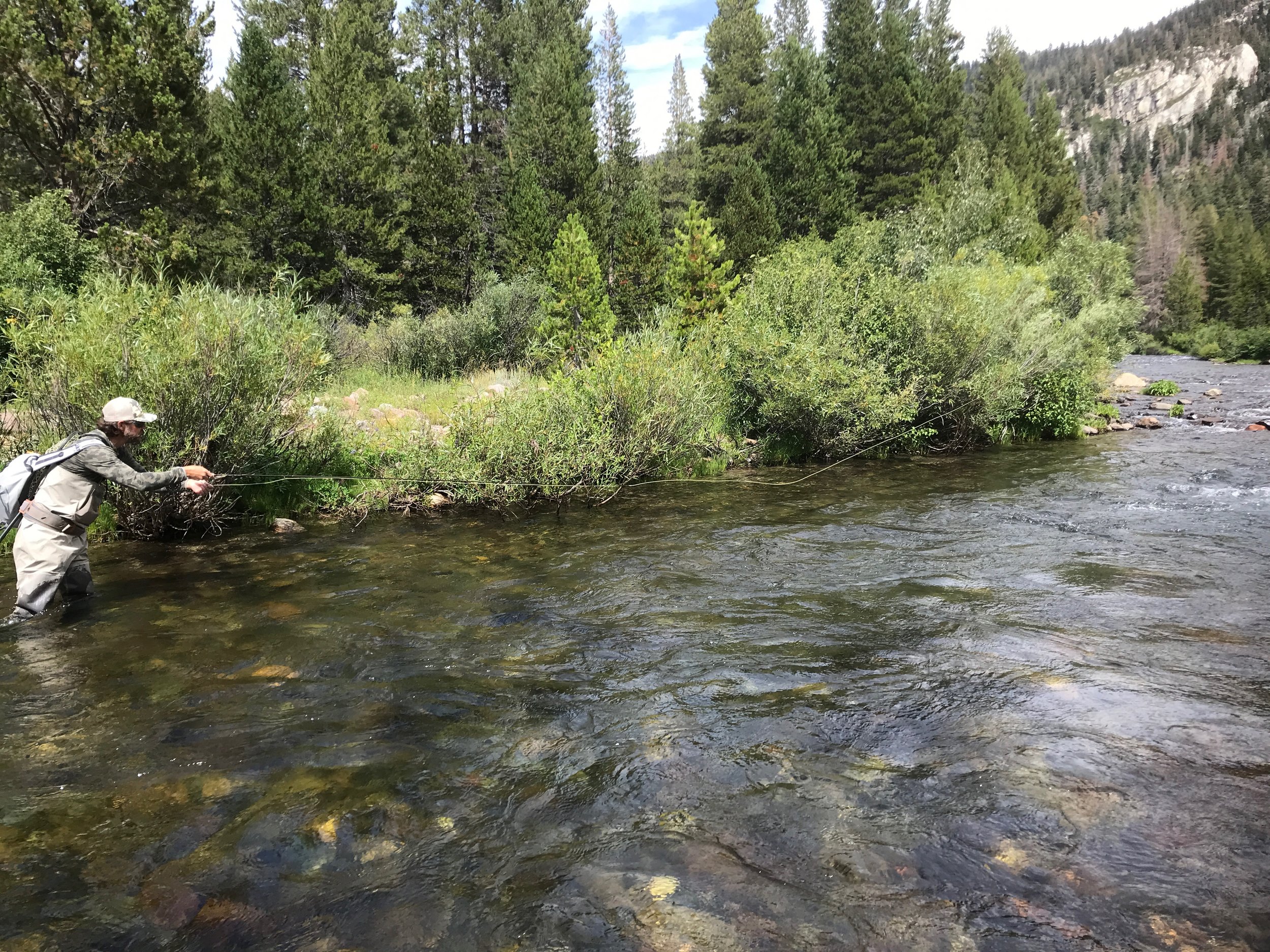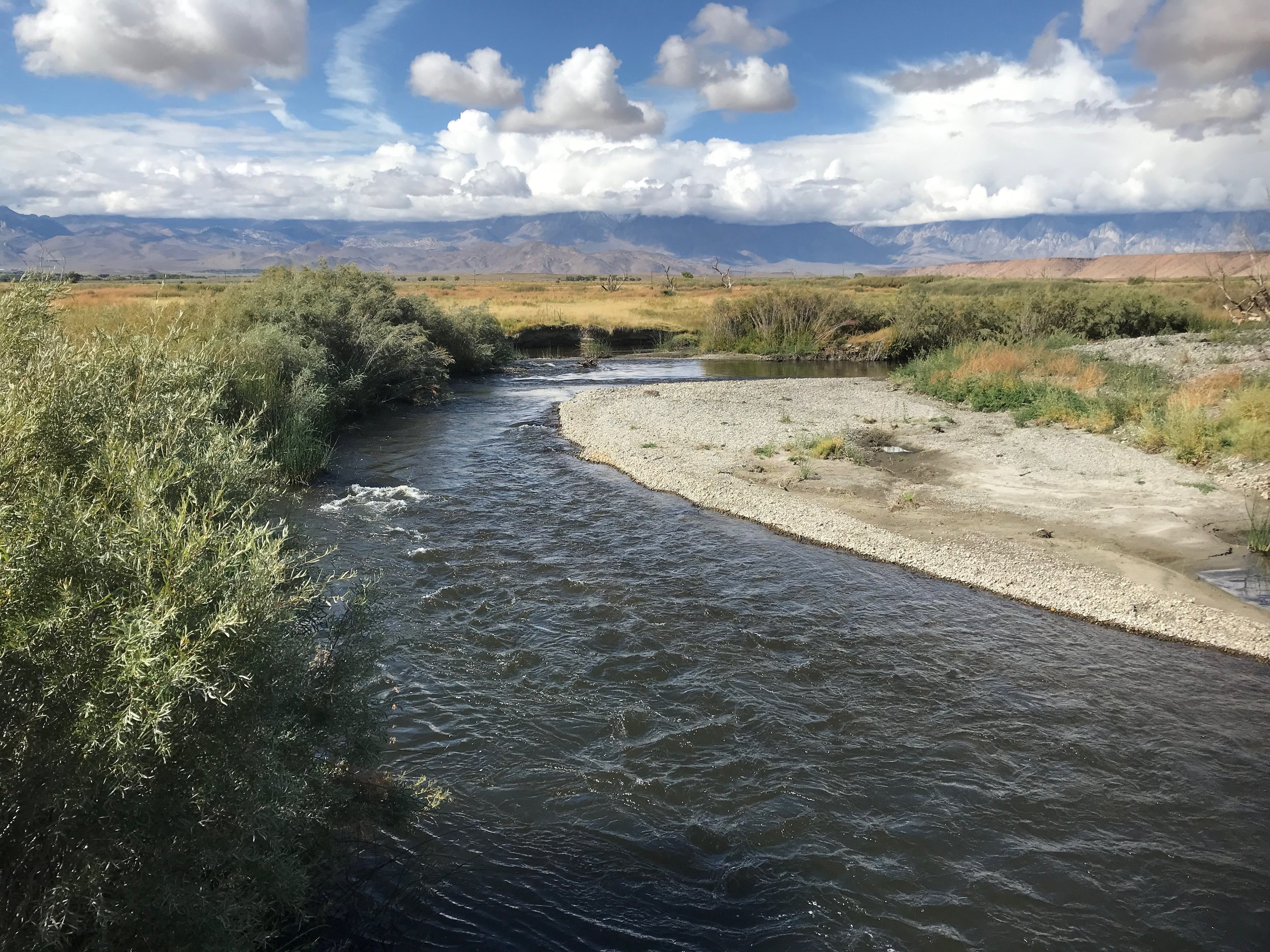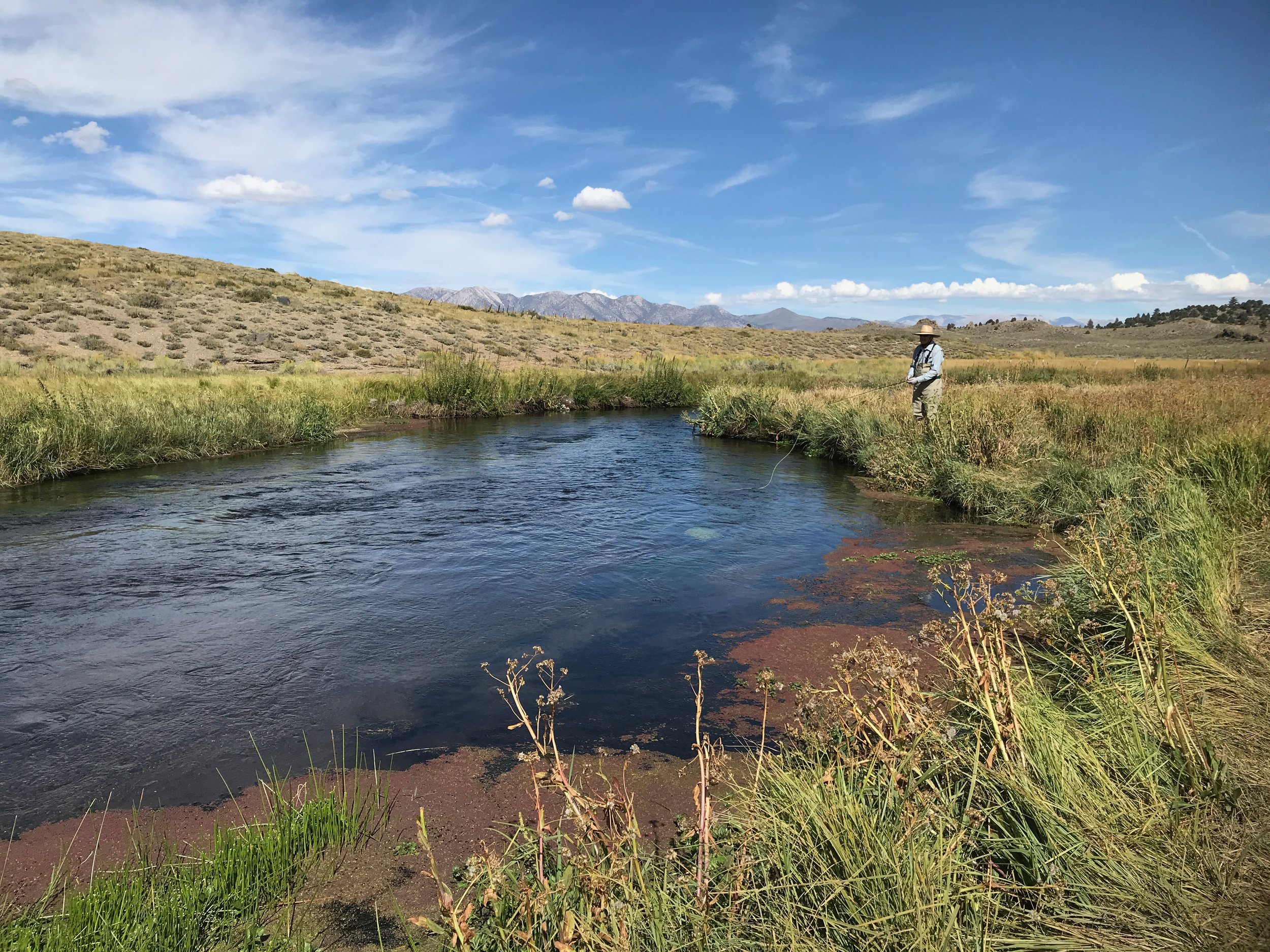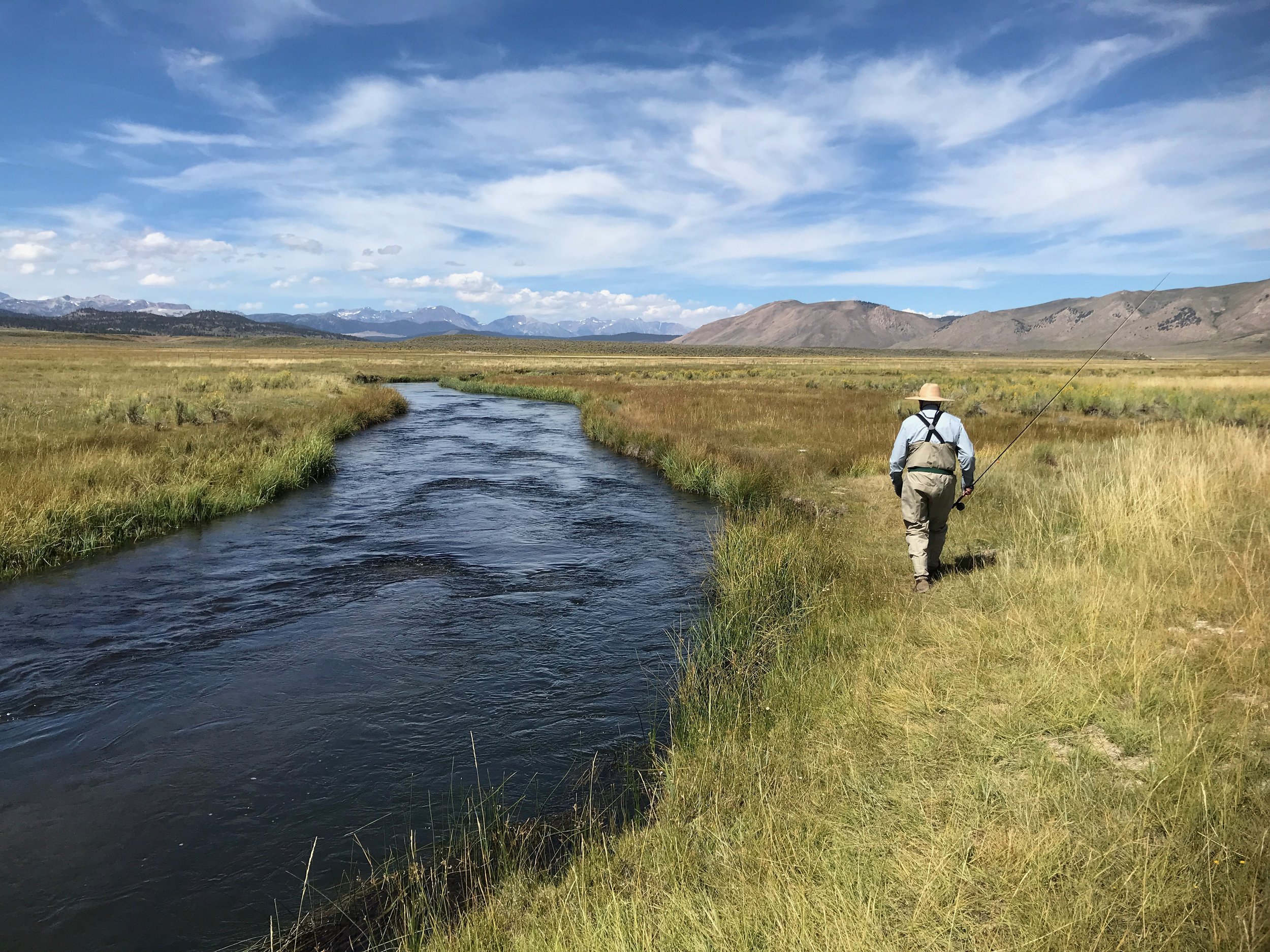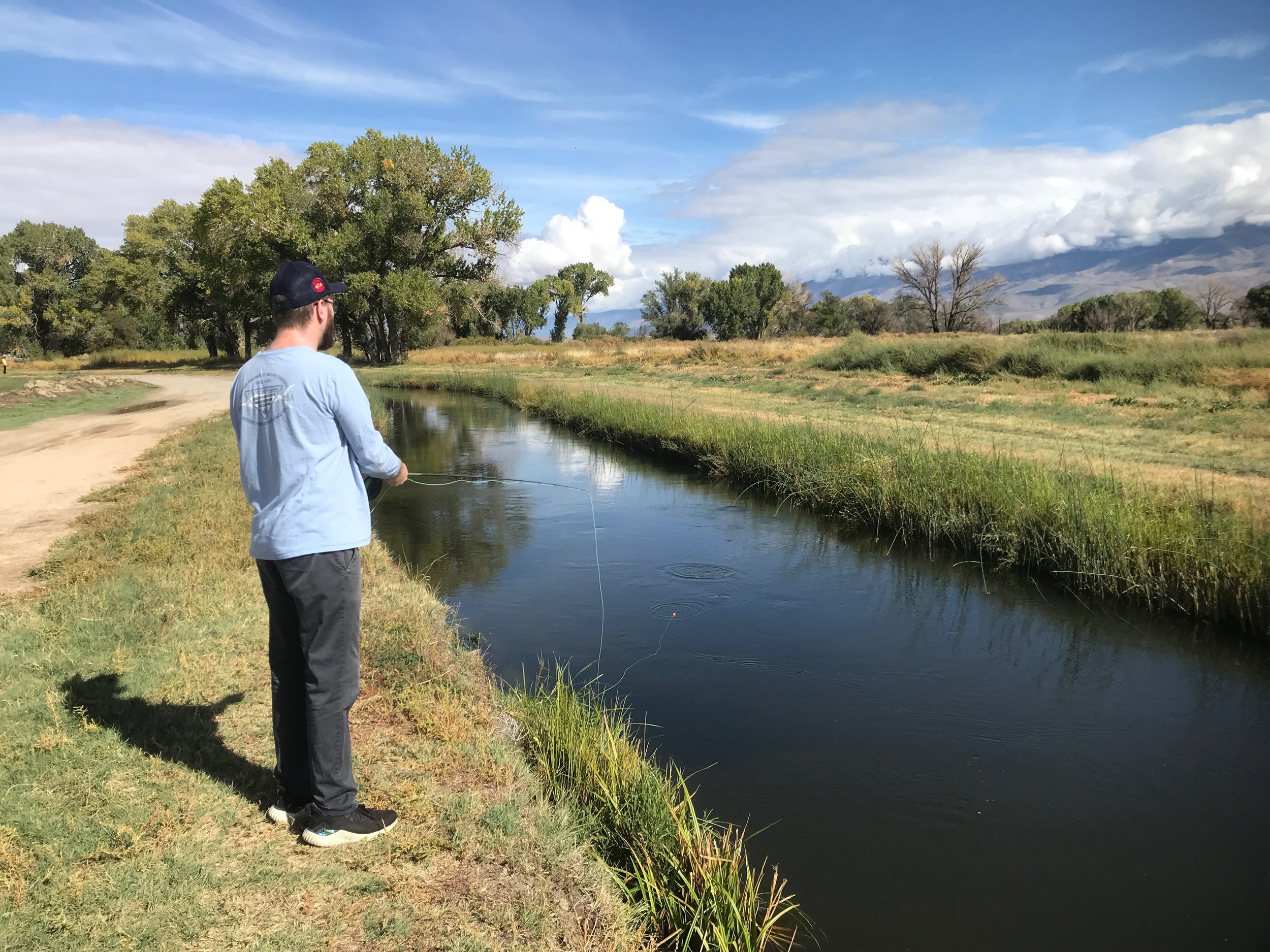It’s prime fall fly fishing time. Trees are yellow and red making a great backdrop to a days fly fishing. Brown and brook trout are in the middle of their spawning seasons. Fall fly fishing produces some of the biggest trout of the fishing season. This is the time of year that fly fishers throw what they call meat, big articulated streamers, for trophy brown trout. Hatches of mayflies, caddis and midges are bringing trout to the surface to feed on the emerging trout.
While there was never a great hopper hatch this year there are still a few hoppers around offering some surface hopper opportunities.
San Joaquin River
Reds Meadow – Agnew Meadows:
This is classic freestone pocket water fly fishing for opportunistically feeding trout. The best dry fly you can use on a freestone water is your favorite dry fly because you will fish it with confidence. For dry flies use size 12 or 14 stimulators in orange or yellow, size 14 or 16 Adams parachutes, elk hair caddis and Royal Wulff’s. This is a great water to fish a dry and dropper rig. For nymphs try size 16 bead head flash back gold ribbed hare’s ears nymphs or size 18 bead head flash back pheasant tail nymphs. Access to the San Joaquin River is only open on Saturday and Sunday.
Sierra Bright Dot guide Richard Lancaster making a cast with his dry fly right next to the willows in the San Joaquin River.
Lower Owens River
Wild Trout Section:
Flows are fluctuating and fly fishers are looking for flows of 300 CFS or less to be able to wade the river. Flows are dropping and expected to drop to 225 CFS by the end of October. Flows for November and December will be back up to 500 CFS. Now is the time to fly fish the wild trout section of the lower Owens River. When the flows allow fly fishers to wade, fishing with nymphs under an indicator or with a Euro rig will be the most productive method of fly fishing the lower Owens River in the wild trout section. Best nymphs will be size 16 bead head flash back gold ribbed hare’s ears, size 16 bead head flash back pheasant tail nymphs, size 18 tiger midges, size 16 hot spot pheasant tail nymphs, size 18 olive quilldigons, size 14 or 16 Butano nymphs and size 12 stoner nymphs.
Fly fishing opportunities from the bank is at a minimum on the lower Owens River in the wild trout section.
Hot Creek
Interpretive Site:
Hot Creek is finally offering consistent dry fly fishing with trico spinners in size 22 and gray parachute caddis in size 20. Hatches are starting in the morning around 9:00 A.M. and are over by noon. After the hatch there are a few caddis around bringing trout to the surface to feed. When the afternoon winds come up try throwing a hopper pattern or a terrestrial like an ant or beetle.
Fishing the deeper holes in the interpretive site with a size 20 gray parachute caddis is producing wild trout mid-morning.
Hot Creek
Canyon Section:
The canyon is producing trout on dry flies and nymphs. Euro nymphing or fishing under an indicator with size 18 olive quilldigons, size 16 hot spot pheasant tail nymphs, size 18 bead head flash back pheasant tail nymphs, Frenchie’s, stoner nymphs and tiger midges are fooling the nymph feeding trout. Key to success is enough weight to allow the nymphs to bounce along the substrate. Fishing with size 20 gray spent partridge caddis, parachute caddis and X-caddis mid-morning is producing brown and rainbow trout to 14 inches.
Fly fishers looking to be successful on the upper Owens River above Benton Bridge need to cover lots of water looking for rising fish with a dry fly or nymphing the deep holes looking for trophy trout.
Upper Owens River
Above Benton Crossing Bridge:
A few trophy rainbow trout are starting to show up in the river. The bulk of the trout being caught up stream of Benton Bridge are in the six to 12 inch range. There is a caddis and mayfly hatch mid-morning that is bringing lots of rainbows and browns to the surface. Size 16 or 18 olive elk hair caddis, parachute blue wing olives or Adams parachutes are fooling the surface feeding trout. The trophy trout are in the deep pools, deep runs and cutbanks resting and feeding. Key to success in this area is covering lots of water to find the few trophy trout that are in this section. Size 12 bead head flash back gold ribbed hare’s ears, stoner nymphs and green/gold Prince nymphs are the flies that are producing the trophy trout.
Alan Kondo from South Pasadena with a trophy rainbow trout caught on a Tenkara rod up stream of Crowley Lake while being guided by Richard Lancaster. Photo by Richard Lancaster.
Upper Owens River
Below Benton Crossing Bridge:
From Crowley Lake to a half mile above the monument is where there is a concentration of trophy trout willing to take nymphs fished on the substrate in the deep holes or deep runs. These trophy trout are looking for a big meal so offer them a size 12 bead head flash back gold ribbed hare’s ears, stoner nymphs and green/gold Prince nymphs. The Euro rig or under an indicator is producing trophy trout for fly fishers that cover lots of deep pools and keep their flies on the substrate where the trout are holding and feeding.
McGee Bay is getting most of the fly fishing pressure as fly fishers are working their flies in the inlets to Crowley Lake.
Crowley Lake:
It’s been a tough year for most fly fishers and guides on Crowley Lake this season. This is the time of the year to be on the lake pulling streamers and nymphs for trophy brown trout. Start out fishing under an indicator. Let the flies sit for about five minutes. No take downs of the bobber it’s time to strip in the flies. A lot of the trophy trout will follow the streamer right into shore or to the boat. Best fly patterns are imitating perch young of the year. Use size 8 or 10 olive wooly buggers, perch balanced leeches and olive matukas. Stripping streamers on a full sink line is a great way to get down where the trout are feeding. For nymphs use size 18 tiger midges, zebra midges, albino Barron’s, size 14 or 16 Prince nymphs, size 10 olive damsel nymphs and size 12 olive gold ribbed hare’s ears.
Beginner fly fisher Steven Monroe learning to indicator nymph on Bishop Creek Canal with a pheasant tail.
Bishop Creek Canal:
Behind the Old Ford Dealer:
The weather middle of the day is perfect for fly fishing on Bishop Creek Canal. Nymphing continues to be the most productive method for fly fishing on the canal. Size 18 bead head flash back pheasant tail nymphs, size 12 green/gold Prince nymphs, size 16 hot spot pheasant tail nymphs and size 12 stoner nymphs are the productive patterns. Moorish hooper, parachute hopper or a Dave’s hopper in size 12 is producing trout when the wind comes up in the afternoons.


